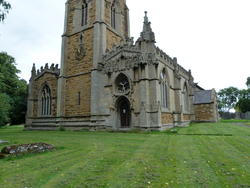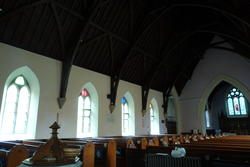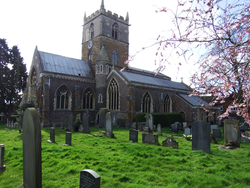
The Corpus of ROMANESQUE SCULPTURE in Britain & Ireland

St Luke (now)
Parish church
Buckfastleigh is a parish to the SE of Dartmoor in Devon, 20 miles SW of Exeter. The original parish church, Holy Trinity (https://www.crsbi.ac.uk/view-item?i=113820), sits in a dramatic position on a hill above the confluence of the River Dart and Mardle between Buckfastleigh and Buckfast. The rest of the town of Buckfastleigh lies below, some distance from Holy Trinity. In 1992, Holy Trinity suffered an extensive fire. The parish built a new church, St Luke's, on the Plymouth Road in the centre of the town, at which point the damaged and reconstructed Romanesque font was relocated from the ruins of Holy Trinity to St Luke's, where it now can be found.
Parish church
Hodnet is a village about five miles SW of Market Drayton. The church lies to the W of the village and consists of a 14thc nave added to the original 12thc S aisle: the S aisle originally functioned as the nave, with N aisle being added in 14thc. Remains of round-headed 12thc windows are found in the S wall of the current S aisle. An octagonal W tower was added to the end of the nave in the 14thc. The building was restored in 1846-7. The only Romanesque surviving sculpture is the octagonal font located at W end of the S aisle.
Parish church
St Luke's was originally a cruciform church and retains its central
tower. The form of the original nave is visible on the W facade, and apparently
had no aisles. The nave has N and S aisles, extended eastwards to subsume the
former transepts, providing N and S chapels. The N chapel now houses lavatories
and a kitchen, and the S is used as a vestry. The
crossing has narrow arches to N and S, and broader,
taller ones to E and W. All four are apparently 14thc., as is the upper part of
the tower, although the lower storey may be 12thc. The nave has a
clerestorey on the S side only, and there are N and S
doorways in the aisles, the S early 13thc. under a porch, and the W windows are also 13thc. work. The
three-bay nave arcades and the
aisle windows date from c.1300, but the W respond of the S arcade is 12thc. An
altar has been installed at the W end of the nave in addition to that at the E
end of the chancel, to make St Luke's a double-ended
church with the two liturgical spaces separated by the crossing.
The font is 12thc.
Parish church
Gaddesby is a village in the Melton district of the county, 8 miles NE of Leicester and 5 miles SW of Melton Mowbray. The church is ooutside the village centre to the E. Pevsner describes the church as 'one of the largest and most beautiful in the county', but the only reminderthat there was onece a Norman church here is a single reset chevron voussoir. St Luke's consists of a 13thc. W tower with a spire, a nave with a 14thc aisles: the slightly earlier S aisle a lavish showpiece with sumptuous details, while the N aile is smaller and humbler though still rich work of the 1330s or '40s. The chancel , of rubble, is earlier than either, Pvesner dated it 1310-15. The church was restored in 1859, when a priests' doorway was added to the chancel.
Parish church
The church is 19thc, architect George Wightwick. The font is 12thc.
Parish church
On the south exterior of the nave is a blocked, medieval doorway, said to be late-12th century. In 1717, it was declared that there was no maintenance for a curate at Clifton Chapel, or any ecclesiastical services performed there. Between 1736 and 1821, the burial ground had ceased to be used and the building was in a state of disrepair. The church was subsequently restored in 1858 and rebuilt in 1900.
Parish church
Avington is in the Hundred of Kintbury, in the SW corner of the county. The village is in the Kennet valley, 2 miles E of Hungerford and 5 miles W of Newbury. The settlement is tiny, consisting of the church and the former manor (now farm buildings) at the end of a lanes running S from the A4. The 12th-century church survives in its entirety, consisting of an aisleless nave with a chancel of the same width but slightly lower. To this was added, in the 13thc, a transeptal N chapel at the E end of the nave; gone now but the present vestry of 1877 is in more or less the same position. A S porch was added in the 16thc. There is no tower, but a bell-cote over the W gable of the nave, that may date from the 13thc. The interior was repaired, paved and seseated in 1765, and a major restoration was carried out by Butterfield in 1848-53, when the 18thc pews were removed and the chancel roof retiled. The church was again refloored in 1903, and in 1910 new roofs were erected on nave and chancel. Avington is valued as much for its sculpture as its architecture, and the main areas of interest are the richly-carved S doorway, the chancel arch, the remains of the chancel rib vault, and the font.
Parish church
The church is entirely Victorian (1878) - described as a 'nasty, fussy
job' by Nairn and Pevsner, p. 274 - with a W tower, an aisled nave and a
chancel, all in the Early English style. The redundant
old church (ded. St Michael) still stands to the E. Although evidently early,
it contains no obviously Norman features.
Parish church, formerly chapel
In 1852-5, St Luke was built on this ancient burial ground. The precise location of the original chapel is not known, and no fragments remain, except the font.
Parish church
Thurnby is a village in the Harborough district of the county, on the eastern border of Leicester itself. St Luke's is in the village centre and is a large cruciform building with a 3-bay aisled nave with a S porch. The chancel is 19thc, the N transept contains the organ and vestry, and the S transept forms the termination of the nave aisle. At the W end of the N nave aisle is a modern parish hall. The lower stage of the tower is 12thc, but the heavy crossing piers have been refaced and their multi-scallop capitals look 19thc. The tower's upper stages are successively 13thc and 14thc. The nave arcades are of the late-13thc., but Slater and Carpenter's restoration of 1870-73 was effectively a complete rebuilding. In the S porch is a rebuilt chevron arch, and this is the only feature recorded here.









